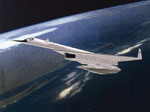Secret Spaceplane Revealed


This should drive all the "Black Helicopter" people around the bend...I for one, find this incredibly cool.
Two-Stage-to-Orbit 'Blackstar' System Shelved at Groom Lake?
By William B. Scott
03/05/2006 04:07:33 PM
SPACEPLANE SHELVED?
For 16 years, Aviation Week & Space Technology has investigated myriad sightings of a two-stage-to-orbit system that could place a small military spaceplane in orbit. Considerable evidence supports the existence of such a highly classified system, and top Pentagon officials have hinted that it's "out there," but iron-clad confirmation that meets AW&ST standards has remained elusive. Now facing the possibility that this innovative "Blackstar" system may have been shelved, we elected to share what we've learned about it with our readers, rather than let an intriguing technological breakthrough vanish into "black world" history, known to only a few insiders. U.S. intelligence agencies may have quietly mothballed a highly classified two-stage-to-orbit spaceplane system designed in the 1980s for reconnaissance, satellite-insertion and, possibly, weapons delivery. It could be a victim of shrinking federal budgets strained by war costs, or it may not have met performance or operational goals.
This two-vehicle "Blackstar" carrier/orbiter system may have been declared operational during the 1990s.
A large "mothership," closely resembling the U.S. Air Force's historic XB-70 supersonic bomber, carries the orbital component conformally under its fuselage, accelerating to supersonic speeds at high altitude before dropping the spaceplane. The orbiter's engines fire and boost the vehicle into space. If mission requirements dictate, the spaceplane can either reach low Earth orbit or remain suborbital.
The manned orbiter's primary military advantage would be surprise overflight. There would be no forewarning of its presence, prior to the first orbit, allowing ground targets to be imaged before they could be hidden. In contrast, satellite orbits are predictable enough that activities having intelligence value can be scheduled to avoid overflights.
Exactly what missions the Blackstar system may have been designed for and built to accomplish are as yet unconfirmed, but U.S. Air Force Space Command (AFSPC) officers and contractors have been toying with similar spaceplane-operational concepts for years. Besides reconnaissance, they call for inserting small satellites into orbit, and either retrieving or servicing other spacecraft. Conceivably, such a vehicle could serve as an anti-satellite or space-to-ground weapons-delivery platform, as well.
Once a Blackstar orbiter reenters the atmosphere, it can land horizontally at almost any location having a sufficiently long runway. So far, observed spaceplane landings have been reported at Hurlburt AFB, Fla.; Kadena AB, Okinawa; and Holloman AFB, N.M.
For the complete story please visit this Aviation
H/T ROFASIX














<< Home